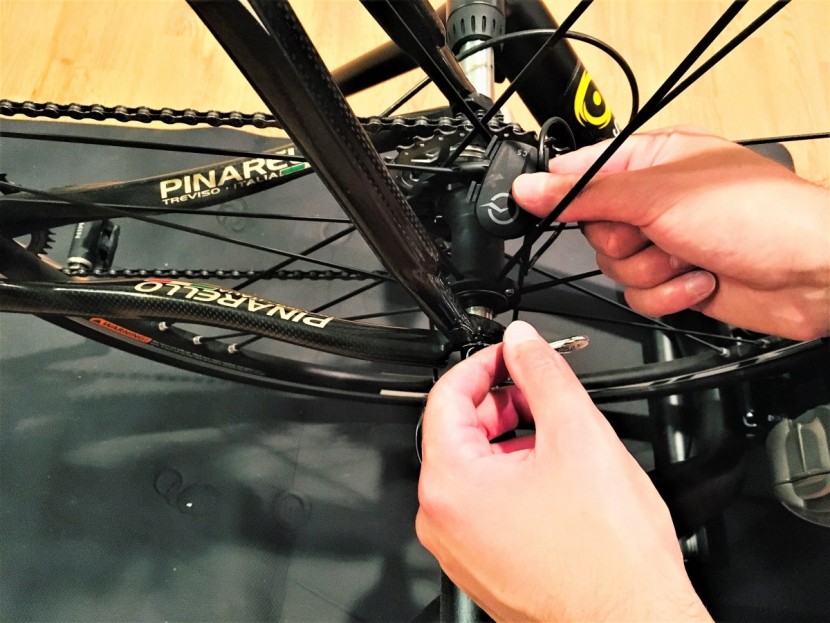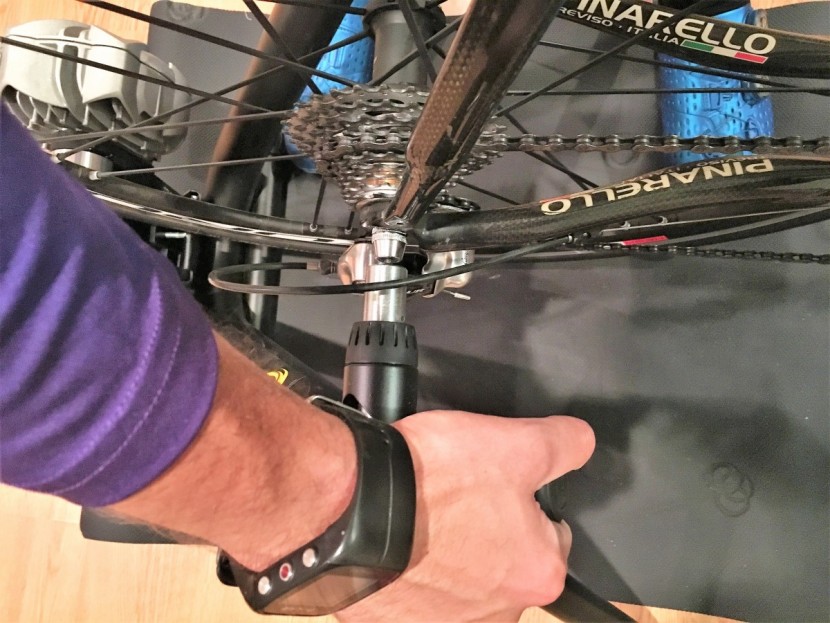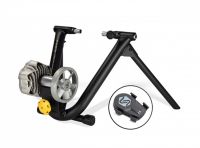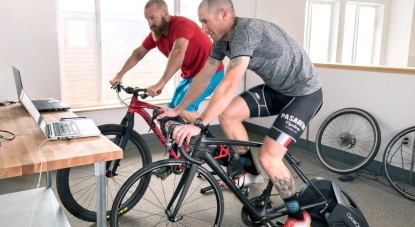Saris Fluid 2 Review

Our Verdict
Our Analysis and Test Results
Connectivity and Power Accuracy
As with many tire drive trainers, the base model is a dumb trainer (meaning no “smart” features), but it can go quasi-turbo by spending a little more and adding a speed or cadence sensor and pairing it with Zwift, Rouvy, or a bevy of other training programs. Now, it doesn't become smart or controllable. Still, it transmits data, and the program responds to the data you're producing, which keeps your stats accurate and hopefully casts some sort of illusory spell to help you trick yourself into better performance.
Given the crutch of not having power data, this machine will not top this test metric. The sensor does a fine job of connecting over its two communication protocols, but that doesn't change the fact that you're only getting speed or cadence data. But if you want to pay enough for good power data, you might as well get a PowerTap or pedals that can pair with your training app with the primary benefit of being able to be used out on the road. That being said, if you're after power (and accuracy), you have lots of impressive options to choose from among the direct-drive models.
Road Feel
The Fluid 2 features a uniquely light flywheel. The high performance without a heavy flywheel is widely attributed to the PowerTuned technology. We researched this pretty exhaustively and couldn't find much beyond power curve charts. Hence, it appears to be more of an ideally-tweaked configuration than an advanced material or mechanical design, but again, we couldn't find much information on it. In any case, the outcome of whatever they did is still pretty sweet because it did as well as other tire drive trainers.
This might be a bit counter-intuitive, but tire drive trainers are at a bit of a disadvantage here. A tire rolling against glassy-smooth rollers feels too clean, too easy, and there's usually a tough balance between slippage (loose resistance unit) and over-squeezing (tight resistance unit). The way Saris overcomes that is with another super simple, super clever design: their clutch knob. It clicks once you've tightened it to the ideal tension, so you're not fooling around with a torque wrench every time you want to ride your bike.
Again, this is a bit hard to determine because of the limited information. Still, it appears that the light flywheel also reduced the unnatural slippage and molasses-feel you sometimes get with heavier, clunkier trainers. That means that when we were coasting for a second or needed to jump on it and start slamming on the pedals, there wasn't a delay because the tire had to get enough traction to push a 20-pound flywheel. It just responds naturally, and the resistance was there when you needed it. In this way, it is a little closer to the direct drives, but it's still just not on the same plane. Not to mention, some direct-drive models have features that allow them to stutter and shake when you cross over cobbles or gravel in Zwift and other training apps.
Still, the Fluid 2 has a relatively natural feel, and it's near enough to the road that it's not a distraction or frustrating, the way the slippier tire drive models can be. For its low cost and simplicity, it's an excellent choice, especially for riders just looking to get a few hours in a week for a short indoor season.
Design
This machine uses the classic design but improves upon it in subtle ways. The most important aspect is the resistance unit, which Saris seems to have mostly mastered. It uses a cooling unit to keep the fluid cool, though, like most fluid trainers, there is a fine balance between overheating and high-heat performance, which they do a fairly decent job of sticking.
Despite the self-cooling fan designed into the flywheel, there are occasional concerns about the tires getting too hot if you're doing 2.5 or 3-hour rides. But if you have a good fan blowing and don't do tons of long rides, your tires shouldn't be any worse for the wear compared to the average tire drive trainer.
It's understandable that it comes in behind the premium smart trainers, but it gets kudos for being both simple and light. It takes the traditional tire-drive design and figures out how to reduce weight without sacrificing performance. Whereas most trainers use extra heavy flywheels to improve the inertia and road feel, the Fluid 2 has a unique design that allows it to sport a flywheel that's only a few pounds, but it still rolls like the models with much heavier flywheels.
No matter how clever the design is, it's hard for tire drive trainers not to eat tires. As we mentioned above, rollers always get hot, no matter what awesome patented design you have, and that heat can lead to accelerated deterioration of tires. That seems to be especially a concern with the Fluid 2, but only for frequent, long rides. That can be addressed relatively easily by using a trainer-specific tire and learning how to change them.
All in all, it's a cleverly simple design that gets the job done, and that's one of the major reasons it earned our Best Buy for Tire Drive Trainer Award. What it lacks in complexity, it makes up for in convenience and practicality.
Setup
This was one of the most pleasing aspects of the trainer. It is really easy to figure out, assemble, mount, and get going from unboxing to rolling. Again, this was a major contributing factor to its Best Buy status. There's nothing like anticipating a ride all day, and when you get home from work, all you have to do is swap skewers (if you want), tighten a few bolts, and fire up your preferred training app.
You'll see that this one lands alongside other top trainers in this metric. The easier initial set-up time definitely goes to the Fluid 2 because it takes about 10 minutes and comes with just about all the tools you'll need.
Not only is the physical set-up easy, but so is the training app piece. That's because Saris doesn't try to trap you in its garden by forcing you to use its native training app - it relies on the robust 3rd party apps. Granted, you have to pay for all or most of those services. Either way, we appreciate that Saris focuses on developing good machines.
Portability
Most tire drive trainers tend to be a bit awkward to carry around. The bulk of their weight is concentrated in the resistance unit and roller, which flops around a bit, but you still have the wide legs and feet to lug around. The Fluid 2 is still designed the same way, but it has the singular advantage of being more than 15 lbs lighter than other top tire drive trainers. For riders after a convenient trainer to warm up at the start line or out on road trips, the clear preference is the lighter, easier to carry Fluid 2.
Weight is the biggest driver for this measure. No matter how ergonomically designed a trainer is, if it weighs almost 50 lbs, we're not going to be terribly fond of taking it out to the start line to warm up for 30 minutes for a 90-minute race. The Fluid 2 really does well here.
Should You Buy the Fluid 2?
Yes. If your goal is a great tire drive trainer with a reasonable price tag that doesn't sacrifice much in the way of performance, then this is the option you want in your at-home training cave. This unit is portable and works well for what it is. The price is reasonable compared to the competition, and we think it sits nicely at the crossroads of useful and affordable.
What Other Bike Trainer Should You Consider?
If you think you might want a standalone unit, check out our exercise bike review for alternatives to a bike trainer.
| Awards | |
|---|---|
| Price | $300 List Check Amazon (on sale!) |
Overall Score  |
|
| Star Rating | |
| Bottom Line | A simple, affordable, and highly functional tire drive trainer with the option to use it with training apps |
| Pros | Quick setup, easy operation, durable, stable, communicates with training apps, low noise |
| Cons | Limited max resistance, roller can heat up and accelerate tire wear, no power data, no control |
| Rating Categories | Saris Fluid 2 |
| Connectivity and Power Accuracy (25%) | |
| Road Feel (25%) | |
| Design (20%) | |
| Setup (20%) | |
| Portability (10%) | |
| Specifications | Saris Fluid 2 |
| Drive Type | Tire drive |
| Measured Weight | 21 lbs |
| Roll Out Time @ 200 watts | 15 seconds |
| Power Comparison | 10 watts, 5% |
| Communication Protocol | ANT+ BlueGiga USB |
| Dimensions L-H-W | 28" x 21.5" x 15.7" |
| Storage Dimensions LxHxW | 20.5" x 9" x 20.75" |
| Type of Trainer | Smart |
| Flywheel | 3 lbs |
| Axle compatibility | 120mm, 130mm, 135mm compatible || Thru-axle available for 142mm and 148mm through CycleOps |













